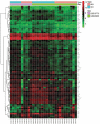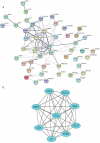Identification of biomarkers, pathways and potential therapeutic agents for white adipocyte insulin resistance using bioinformatics analysis
- PMID: 31407623
- PMCID: PMC6768254
- DOI: 10.1080/21623945.2019.1649578
Identification of biomarkers, pathways and potential therapeutic agents for white adipocyte insulin resistance using bioinformatics analysis
Abstract
For the better understanding of insulin resistance (IR), the molecular biomarkers in IR white adipocytes and its potential mechanism, we downloaded two mRNA expression profiles from Gene Expression Omnibus (GEO). The white adipocyte samples in two databases were collected from the human omental adipose tissue of IR obese (IRO) subjects and insulin-sensitive obese (ISO) subjects, respectively. We identified 86 differentially expressed genes (DEGs) between the IRO and ISO subjects using limma package in R software. Gene Set Enrichment Analysis (GSEA) provided evidence that the most gene sets enriched in kidney mesenchyme development in the ISO subjects, as compared with the IRO subjects. The Gene Ontology (GO) analysis indicated that the most significantly enriched in cellular response to interferon-gamma. The Kyoto Encyclopedia of Genes and Genomes (KEGG) pathway analysis revealed that the DEGs were most significantly enriched in cytokine-cytokine receptor interaction. Protein-Protein Interaction (PPI) network was performed with the STRING, and the top 10 hub genes were identified with the Cytohubba. CMap analysis found several small molecular compounds to reverse the altered DEGs, including dropropizine, aceclofenac, melatonin, and so on. Our outputs could empower the novel potential targets to treat omental white adipocyte insulin resistance, diabetes, and diabetes-related diseases.
Keywords: DEGs; Insulin resistance; bioinformatics; hub gene; omental adipocyte.
Figures







Similar articles
-
Bioinformatics analyses of significant genes, related pathways and candidate prognostic biomarkers in glioblastoma.Mol Med Rep. 2018 Nov;18(5):4185-4196. doi: 10.3892/mmr.2018.9411. Epub 2018 Aug 21. Mol Med Rep. 2018. PMID: 30132538 Free PMC article.
-
The identification of key genes and pathways in hepatocellular carcinoma by bioinformatics analysis of high-throughput data.Med Oncol. 2017 Jun;34(6):101. doi: 10.1007/s12032-017-0963-9. Epub 2017 Apr 21. Med Oncol. 2017. PMID: 28432618 Free PMC article.
-
Analysis of the different characteristics between omental preadipocytes and differentiated white adipocytes using bioinformatics methods.Adipocyte. 2022 Dec;11(1):227-238. doi: 10.1080/21623945.2022.2063471. Adipocyte. 2022. PMID: 35499169 Free PMC article.
-
Identification of candidate biomarkers and pathways associated with SCLC by bioinformatics analysis.Mol Med Rep. 2018 Aug;18(2):1538-1550. doi: 10.3892/mmr.2018.9095. Epub 2018 May 29. Mol Med Rep. 2018. PMID: 29845250 Free PMC article.
-
Identification of Metabolism-Related Proteins as Biomarkers of Insulin Resistance and Potential Mechanisms of m6A Modification.Nutrients. 2023 Apr 11;15(8):1839. doi: 10.3390/nu15081839. Nutrients. 2023. PMID: 37111057 Free PMC article.
Cited by
-
Proteomics of serum exosomes identified fibulin-1 as a novel biomarker for mild cognitive impairment.Neural Regen Res. 2023 Mar;18(3):587-593. doi: 10.4103/1673-5374.347740. Neural Regen Res. 2023. PMID: 36018182 Free PMC article.
-
Novel diagnostic and prognostic biomarkers of colorectal cancer: Capable to overcome the heterogeneity-specific barrier and valid for global applications.PLoS One. 2021 Sep 2;16(9):e0256020. doi: 10.1371/journal.pone.0256020. eCollection 2021. PLoS One. 2021. PMID: 34473751 Free PMC article.
-
Gene Expression Analysis and Validation of a Novel Biomarker Signature for Early-Stage Lung Adenocarcinoma.Biomolecules. 2025 May 31;15(6):803. doi: 10.3390/biom15060803. Biomolecules. 2025. PMID: 40563443 Free PMC article.
-
Cell-intrinsic insulin signaling defects in human iPS cell-derived hepatocytes in type 2 diabetes.J Clin Invest. 2025 Apr 15;135(8):e183513. doi: 10.1172/JCI183513. eCollection 2025 Apr 15. J Clin Invest. 2025. PMID: 40231468 Free PMC article.
-
SPRY4 promotes adipogenic differentiation of human mesenchymal stem cells through the MEK-ERK1/2 signaling pathway.Adipocyte. 2022 Dec;11(1):588-600. doi: 10.1080/21623945.2022.2123097. Adipocyte. 2022. PMID: 36082406 Free PMC article.
References
-
- Fantuzzi G. Adipose tissue, adipokines, and inflammation. J Allergy Clin Immunol. 2005;115: 911–919. quiz 920. - PubMed
Publication types
MeSH terms
Substances
LinkOut - more resources
Full Text Sources
Medical
